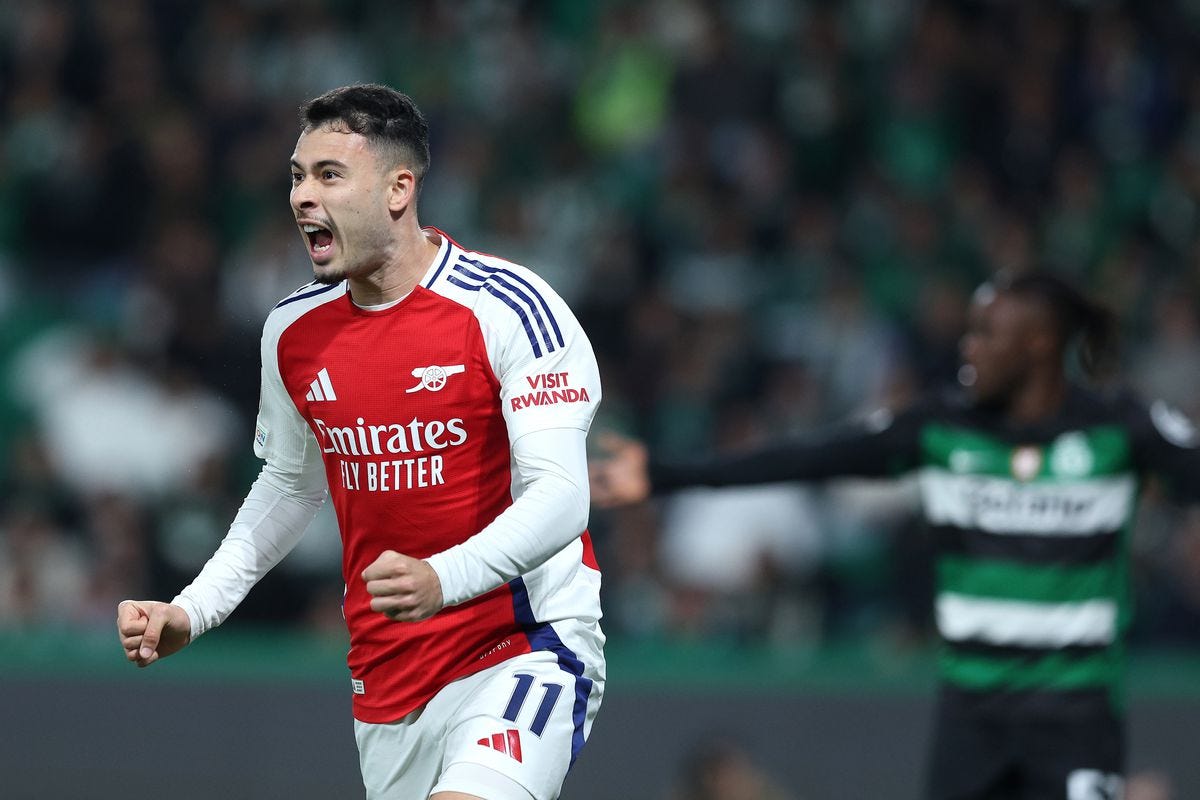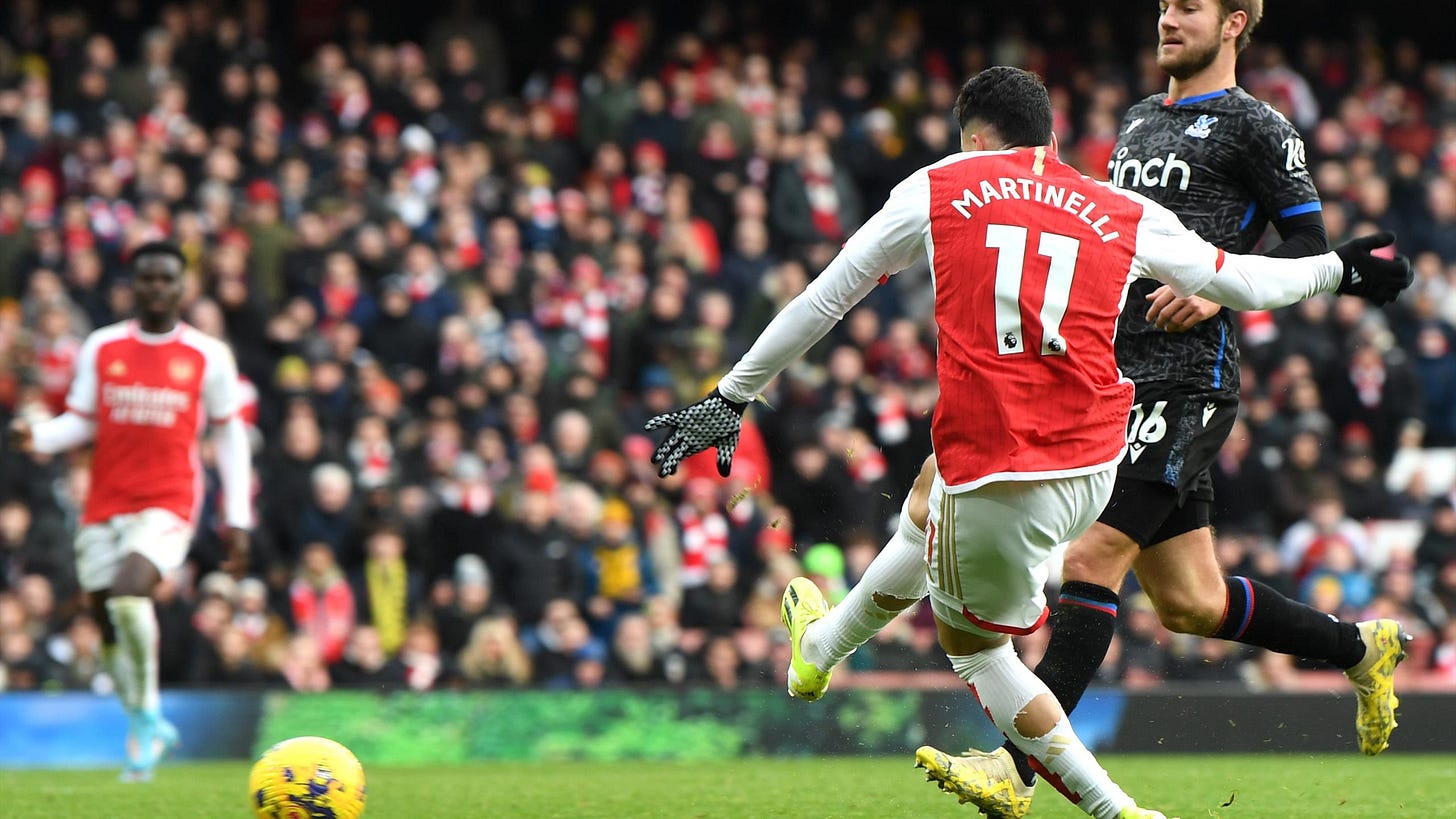The Last Man on the Left
It's been a tough couple of years for Gabriel Martinelli. As Arsenal are linked to more left wingers by the day, how might he fit in the team's ecosystem next year?
It’s hard not to get caught in a riptide of optimism during Gabriel Martinelli’s runs of form. His energetic, relentless style and directness bring a palpable energy to the team and everyone watching. With each swivel into the outside channel and stinging shot, or well-chosen cross, it can feel tantalisingly like the Martinelli of the 22/23 season is back amongst us.
It’s similarly difficult not to take a dim view of his bad spells. The simplicity of his style also makes it even more frustrating when things aren’t working. That persistence and relentlessness start to appear brainless, and his direct approach takes on the air of someone attempting to write an essay in crayon.
Martinelli’s 22/23 was exceptional. 15 league goals crowned a brilliant individual campaign, and although there were still elements to improve, it felt like the clear potential was being realised. He was the joint-top scorer, and had a habit of making his contributions matter. He was key in big games and moments, and when it came to the run-in, Martinelli unquestionably turned up. Unfortunately, a particular few emphatically did not.
The last two seasons have been stop-start, a mix of struggles for form and nastily timed injuries that have seen him fail to build on that campaign. But within those frustrations there have always been moments and runs that underline the value of persisting with him, even when his showings make it difficult to want to.
Even in this tough couple of years, he’s kept that habit of contributing in big moments. In 23/24 his deflected goal gave Arsenal a seismic-seeming 1-0 win over Manchester City, and he caused and capitalised upon Virgin van Dijk and Allison’s mix-up to re-claim the lead against Liverpool. In 24/25 he has put in excellent showings against Real Madrid, Chelsea and Manchester City, but with far too much filler in between those highs.
Martinelli’s scrappiness, combined with that persistence, are part of what makes him such a value add in those big games. He plays games on the edge, takes risks, and makes impulsive attacking decisions that can be the difference in tight moments. But not consistently enough.
Through the first half of 23/24, Arsenal’s structure was something of a mess. Mikel Arteta attempted to integrate two thirds of a new midfield, stylistically a world apart from the preceding version, at once. The alterations cut Martinelli adrift somewhat. With that, oppositions’ approach to Arsenal changed dramatically. Almost every game was Arsenal against a deep-sitting block; less space to attack and weaker routes into getting Martinelli into play only served to isolate him further. Far too often, Martinelli has been alone on the wing, left alone to manufacture a way to beat two players in one swoop.
Martinelli had previously struck up fruitful relationships with both Granit Xhaka and Gabriel Jesus. Together, with Alex Zinchenko, they formed a layered and ever-populated left side to go opposite the team’s creative hub on the right. By the early stages of 23/24, Xhaka had departed and it took until December for Jesus to reach three starts at centre forward.
Going from Xhaka to Kai Havertz in midfield was a significant shift, as was Declan Rice learning the intricacies of the sitting role in Arteta’s setup. The plan had merits, but its being unrolled all at once meant that it made Arsenal significantly worse at moving the ball through the midfield, among other things, all while the team became more favouring of its right side.
Balance eventually arrived with Declan Rice’s move to that ‘left 8’ position and Havertz to centre forward. Despite Rice’s right-footedness and Havertz’s right-side bias, along with Jakub Kiwior’s more defensive presence at left back, Martinelli did appear to be finding some semblance of form, before a nasty challenge in the win at Sheffield United in early March saw him pick up an injury.
He only missed one Arsenal game in full, but he was clearly still not ready to start after the international break that followed it. From then, Leandro Trossard firmly claimed the left wing spot, and Martinelli’s only start in the final 10 games of the season was on the final day, on the right in the injured Bukayo Saka’s place.
The signings of Mikel Merino and Riccardo Calafiori were clear attempts from Arsenal to create an updated, adjusted version of the 22/23 left-side structure, but injuries and yet more teething issues meant it never quite got going. Arteta became more committed to Rice at ‘left 8’, and injuries ensured problems right across the forward line.
So, up to a few weeks ago, when he started to play with that zip and a far greater effectiveness to go with it, it had been more of the same for Martinelli. With Saka’s lengthy injury he found more minutes on the right, where he has proved to be a very capable second fiddle. Against Chelsea, Fulham and Real Madrid he excelled, playing across both wings. Meanwhile, in the weakened team against Brentford, he looked a lot more like the Martinelli we have seen far more this last two seasons.
It goes to show that despite those moments and spells, Arsenal need to act. Martinelli’s inconsistency and Trossard’s apparent decline mean the left wing is arguably an even bigger point of focus for this summer than centre forward. Martinelli has undoubtedly been the victim of circumstance, but short of him taking on swift and significant improvement, Arsenal need more from the left wing.
Whether that player is Bradley Barcola, Nico Williams or another, there is a need for more. Though, when considering the requirements against what Martinelli does provide, in some ways you do just find yourself describing an in-form Martinelli. A player who plays with real intensity, who runs at defenders, scores and creates, has the unpredictability to go down the channel or cut inside, and, crucially, is not fazed by the big occasions.
However, there is no running from what Martinelli lacks. Consistency, of course. While the Brazilian’s scrappiness has many uses, a greater level of technical security absolutely wouldn’t go amiss. Most of all, though, it’s that ability to play within and without the system.
Where the setup around him has had its issues, Martinelli has really suffered with it. In a similar boat, Saka and Havertz struggled, to differing degrees, but consistently had impact. Martinelli, and Trossard with him, did not, which only exacerbated Arsenal’s difficulties. Life without Saka showed how much Arteta’s side need to reduce their reliance on him, and while easier said than done, a high quality addition down the left is the biggest step towards doing that.
If another left winger is signed, Martinelli has a fight for his place on his hands. If he finds himself not starting, his pace off the bench is a superb weapon to have, as is his ability on the right, which can help to give Saka a few more breaks. It doesn’t preclude him having a big role to play, nor the possibility that he can look more like his 22/23 self and earn his place back.
While his swings in form have been understandable, two relatively indifferent seasons mean this is a significant moment for the 23-year old. It’s worth sticking with him and, in whatever role he may have next season, he needs to show the world why.





